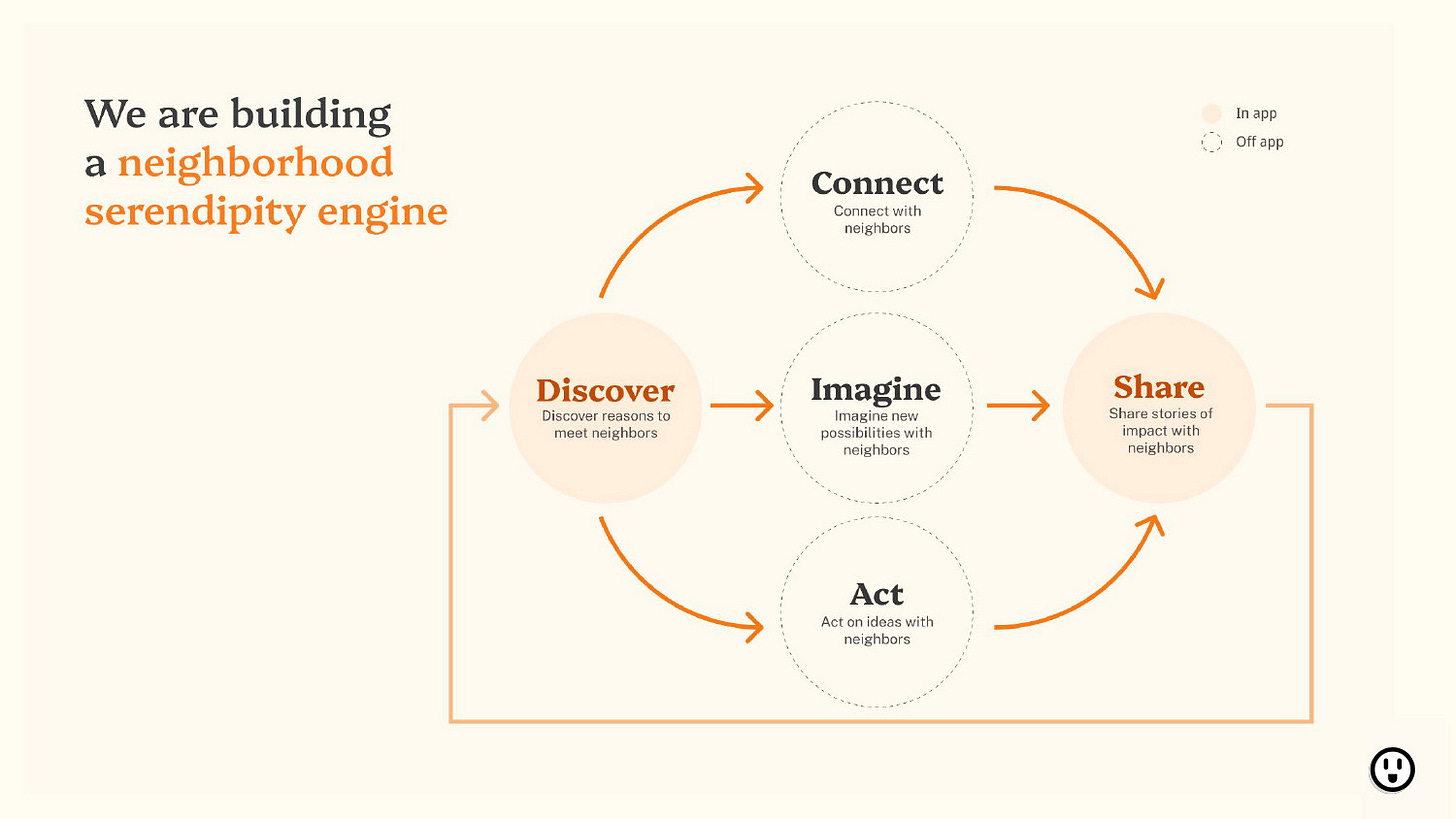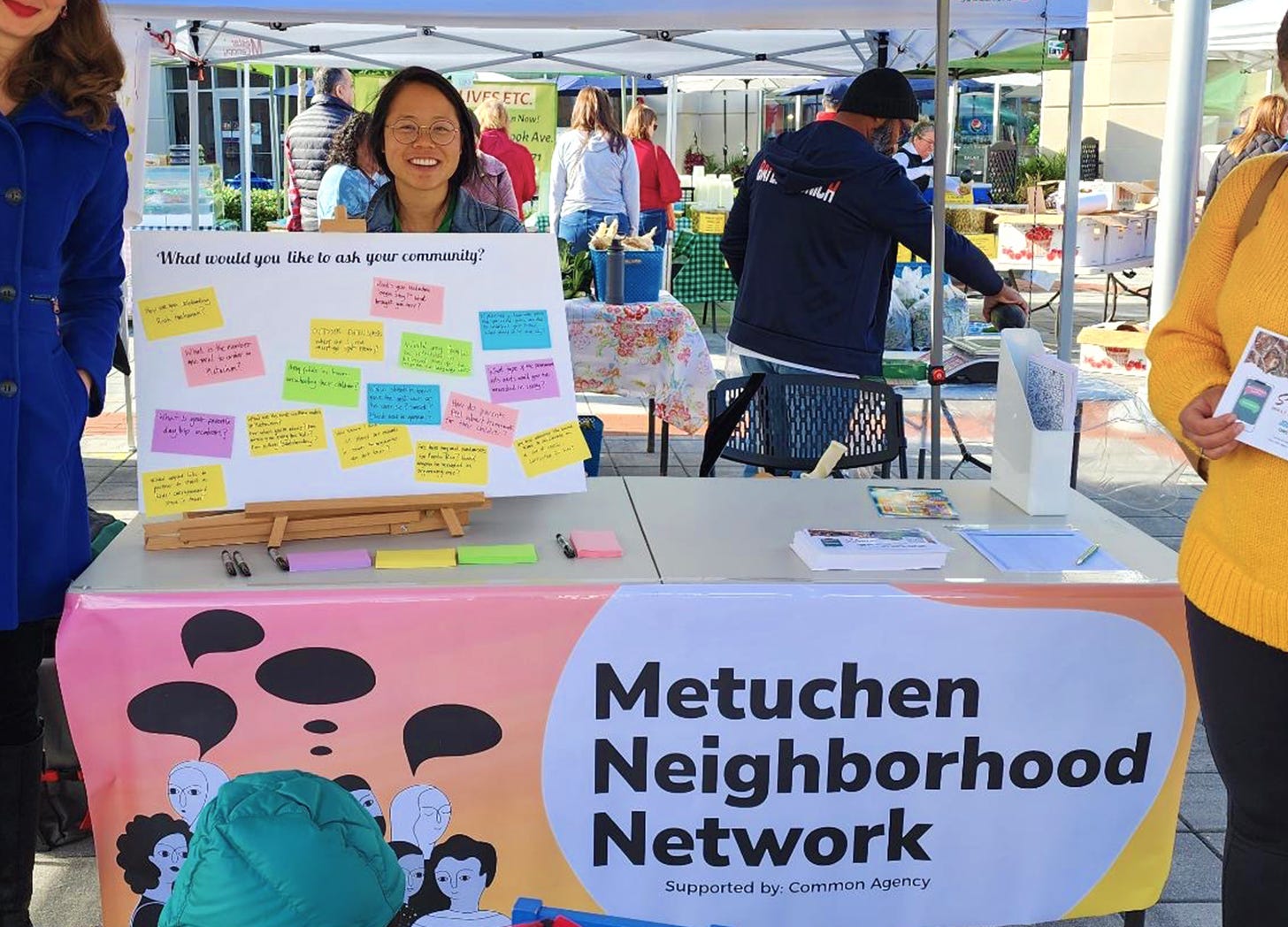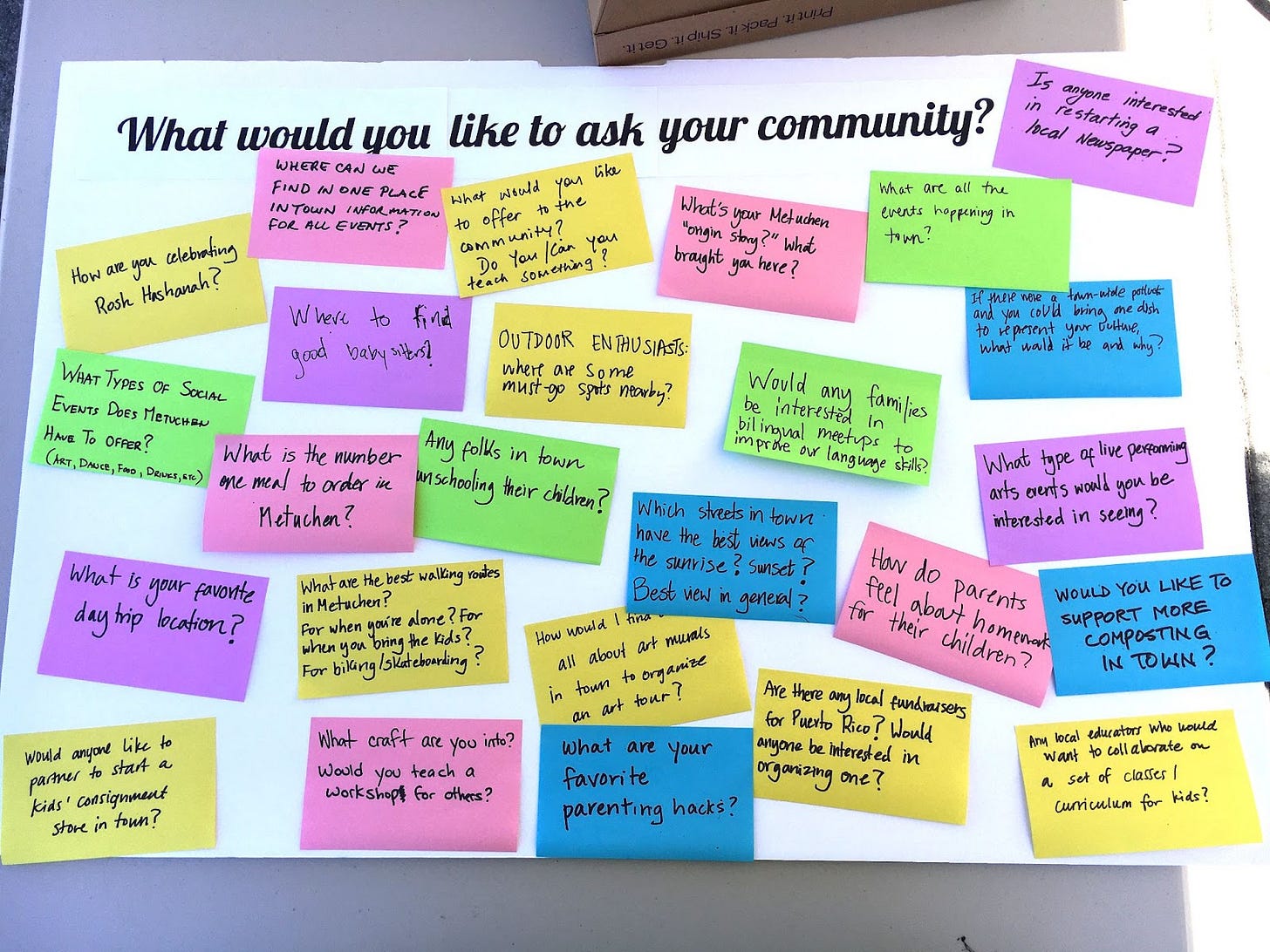👋 🏘️ Why don’t we know our neighbors?
How Common Agency is piloting new tech to bring people together
New_ Public is seeking a Social Media Fellow and also a Research Fellow for our Local Lab.
Have you ever had a neighbor help you out when you really needed it? Once, I was an hour away from home and my back door (which I forgot to lock) blew open and my alarm went off. My neighbor across the street, who I had mostly only greeted in passing before, helped me navigate the emergency, including dealing with the police officers who arrived to help. Neighbors, even when you only know them a little, can be vitally important. So why do we often not take the time to get to know our neighbors?
This is where we start this week, with an essay from Friend of New_ Public and Founding Steward of Common Agency, Deborah Tien. Common Agency has spent the last couple of years piloting different iterations of hyperlocal, technology-enabled civic infrastructure that encourages neighbors to connect, imagine, and act together to shape their neighborhoods to feel more like home.
It’s fascinating to see Deborah’s process and read some of her insights. Common Agency’s work really resonates with what we’re doing at New_ Public and gels with our own work in local digital spaces. Her focus on bringing neighbors together and increasing belonging is worthy of far more attention and support.
– Josh Kramer, Head of Editorial, New_ Public
Why is it so hard to meet neighbors? You might make long trips to visit family, friends, and colleagues, yet it can take years to get to know the people who live closest to you.
It seems simple, but it took me a few years of facilitating dialogue and design workshops; reading books like Priya Parker’s The Art of Gathering; conversing for hundreds of hours with neighborhood organizers; researching what works in participatory governance; and implementing a couple of failed experiments before I realized that this was probably amongst the biggest challenges to helping US neighborhoods come together: most people don’t have good reasons to meet their neighbors.
Even in public spaces (which are not used by everyone equally), it can feel high-stakes to meet neighbors, because you want to avoid making a bad impression or leaving things in a strained or even dangerous place with someone so close by. And it generally feels low-urgency, because there are usually no deadlines for meeting neighbors (until we receive a social prescription from a doctor or disaster strikes). It also, frankly, feels a bit countercultural, because unless we are bonding over children or dogs (which are perfectly great reasons to connect), we’re taught to mind our own business and not invade the privacy of others.
With digital technologies, it can seem like we don’t need to meet neighbors because we can find directions, get restaurant recommendations, or even make friends through apps and websites. These ways are more convenient, more on-demand, and they avoid the messiness of human relationships.
But I wonder: would it be possible to use digital technologies to help us find good reasons to meet our neighbors? Here are a couple of experiments I have tried.
Lesson One: Find commonalities, as niche as possible
At Common Agency, we work towards a future where everyone is proud of where they grow up and grow old. We want to support the nearly three-quarters of US adults who report a sense of non-belonging in their local communities. We define belonging as a combination of role and fit.
We see that building a sense of belonging leads to increased collective efficacy, or the ability for a group to achieve a shared purpose together. We see more collective efficacy leading to strengthening belonging even more. It’s a great positive feedback loop that we want to help unlock within neighborhoods.
Let’s first look closer at fit. For many, fit means finding a place where they share commonalities with others. Sometimes this is through an identity-based affinity group, while other times it’s a shared interest like basketball or community gardening. Whatever it is, the hope is that people gather over what they have in common and build relationships.
Last year I tried to surface more commonalities by experimenting with text- and email-based “Neighborhood Networks” in Holland, MI, (specifically in the Eastcore neighborhood, partnering with 3sixty) and Metuchen, NJ (partnering with passionate community members). About 100 people signed up to receive one question a week via text or email from another neighbor. These questions were decided on by local volunteers called “Network Stewards,” who also invited neighbors to join by tabling at local community events like farmers markets, block parties, and school fairs, and by posting on Nextdoor and local Facebook groups.
After nearly a year of designing questions with Network Stewards, often during 10pm meetings after their kids went to bed, most questions fit roughly into four categories:
Get-to-know-you: “If there were a town-wide potluck and you could bring one dish to represent your culture, what would it be and why?”
Local recommendations: “What are your favorite walking routes in the area? Are you interested in finding walking partners?” or “What do you think about [a neighbor’s] composting project? Would you like to support it?”
Opinion: “What do you think about bicycle lanes?” or “What do you think about homework for children?”
Imagination: “What is important about intergenerational relationships, and how can we strengthen them in our community?”
Neighbors could respond to the questions via text or email, and responses were shared in a separate web app. Sometimes I’d put together a simple slide deck outlining similar responses and inviting neighbors to meet. For example, I made this deck to see if two neighbors who didn’t know each other might consider planning a potluck together. When it didn’t work, I wondered: Was everyone simply too busy to get to know their neighbors?
Apparently not, because other events did emerge from our Neighborhood Networks. In Eastcore, Network Steward Lori, an avid gardener, used her Neighborhood Network to set up a plant exchange where dozens of trays of plants were exchanged in less than an hour. Vika, a Metuchen Neighborhood Steward who immigrated from Ukraine and married a Korean-American, set up a multilingual story time. She glued translations into children’s books and invited neighbors to read a story out loud in their own languages.
I learned that people are willing to go out of their way to organize and gather with their neighbors — but the reasons need to be specific. The gathering should make people realize how they fit together. If it feels like it could only happen here, at this moment, with these people, then that’s a good reason to meet with neighbors.
To inspire these types of gatherings, we needed to create more opportunities for people to find more niche commonalities with their neighbors. So I put a pause on our weekly questions and started inviting people to help us co-design something that is more people-centric.
Lesson Two: Surface ways to contribute with neighbors
The other key part of belonging is role. For many, having a role is about competence and confidence, so you see that your unique contributions are shaping your community. Before getting started, a lot of people look for resources to execute their role well.
Two years ago, along with my friend Dustin, I created a new resource: a block party planning toolkit. The year before, we had talked to organizers around the country, and many cited block parties as a core tool for bringing their neighborhoods together.
However, we learned that the same one or two people usually planned the block party every year, and when those people got tired or needed to take care of other things, there were no more block parties. So, to encourage new people to gain the confidence and competence to plan block parties, we hacked together something like a block party wiki using the no-code tool Coda, with checklists sourced from experienced block party planners. It also included:
An equipment library (built with Airtable and Softr) so neighborhood associations and other groups could share and reuse equipment like speakers and chairs.
An integrated RSVP that allowed planners to send emails and texts to attendees with a single click for reminders or last-minute updates.
A block party mood board (built with Miro) so organizers could see and share block party tips and tricks.
I was excited by how comprehensive this became! Wouldn’t this make life easier and lead to some 🔥 block parties? But surprisingly, feedback was mixed. While some liked being able to communicate and coordinate more easily, many neighbors worried that it was too focused on the goal without considering the journey.
For instance, a government official working in community engagement in South Bend, IN, said that the most meaningful part of planning a block party was the informal brainstorming and planning over a shared bottle of wine in a neighbor’s backyard. While planning, they would also support each other through day-to-day challenges, talk about dreams for the future, and build on the neighborhood’s folklore. In other words, planning for the block party was almost an excuse to gather and deepen relationships. Another reason to meet neighbors is when you're able to have a role in building something meaningful and fun.
I paused the block party planning toolkit and started inviting people to help us co-design a new approach. I wanted to showcase each neighborhood’s ever-evolving roster of projects, assets, and accomplishments — generating a sense of possibility and inviting people to contribute their gifts to existing projects or to exploring their own ideas.
What we’re building now
From these foundations, I’m now experimenting with a concept around neighborhood serendipity engines. This is also inspired by Audrey Tang, Taiwan’s First Minister of Digital Affairs, on increasing the bitrate of democracy by creating more opportunities for people to participate. Can we increase the bitrate of neighborhoods?
I’m working with some amazing friends and a few groups of Network Stewards around the country to build and test an app for people to (1) introduce themselves more holistically and (2) receive suggestions for people, events, or projects that might interest them.
The main role of our digital space is to help neighbors to find good reasons to meet. Then we want to get neighbors to meet each other offline, sometimes partnering with local facilitators and bridging organizations like Urban Rural Action to co-host spaces for dialogue and resolving conflicts across differences. Our hope is that neighbors discover something new about their neighborhood, their neighbors, and themselves — and share these discoveries on the app, to invite more neighbors into each other’s stories.

Introductions: Instead of a single onboarding and profile-writing session when neighbors join the app, they are periodically prompted with questions over time. As neighbors answer, their responses are also added to their profile pages. To avoid having most people lurk and not participate, we’re working with our community partners to run complementary activities in-person. For instance, our partner Community Renewal in Shreveport, LA, poses a question as an icebreaker at their bi-monthly meetings. Then they add images of hand-written and hand-drawn responses into the app for other neighbors to see.
To offer more ways for neighbors to find their own fit and role, the app also showcases local organizations and initiatives and their upcoming events and ongoing projects, as invitations for others to join. We’re figuring out how to technically integrate individuals and groups and how to catalyze more small groups to test different ideas. We’re learning from Community Renewal’s primarily offline approach of spinning up “Learning-Doing Groups” (from Strategic Doing). We’re also inspired by Microsolidarity “crewing” practices.
Suggestions: Network Stewards send personalized recommendations to neighbors, suggesting events, projects, groups, and neighbors to consider connecting with. In the future, we may leverage recommendation algorithms to provide initial suggestions to Network Stewards, but we think human discernment will always remain important to build trust in our approach.
We’re also exploring more ways for neighbors to surface their own commonalities. This might include features that allow neighbors to tag each other in their responses, pages that show all neighbors who have expressed interest in a particular topic, and collective annotation systems with partners like Reliabl, for neighbors to tag posts and create community-generated filters.
We’d love your help
We’ve been learning a lot by co-designing this app with Network Stewards who have a wide variety of experience: local librarians, formerly incarcerated neighbors, corrections officers, church pastors, YMCA staff, small business owners, nonprofit directors, third shift workers, and parents. They have a range of socioeconomic, educational, and cultural backgrounds. There are still many questions to answer.
Alongside our four pilots in Louisiana and Wisconsin, we would love to set up six more pilots in different parts of the US, ideally across a mix of urban, rural, and suburban neighborhoods. If you think your neighborhood would be a good fit and you might be interested in serving as a Network Steward, or you are interested in funding this work, I’d love to hear from you. Common Agency also has a long way to go in design, data, communications, and software development. I'd love to hear your feedback, ideas, and questions — please reach out through our website.
Thank you for your attention, and may you spend time outside with your neighbors! Maybe even for National Good Neighbor Day on September 28 🌱
Let’s co-create neighborhoods we're all proud to grow up and grow old in.
Thank you to the many amazing people who have contributed their time and heart into this project. For this newsletter piece, special thanks to Facundo Lucci, Nathan Schneider, Val Elefante, Andy Crosbie, Elena Kakwani, Nadja Nickel, Teju Ravilochan, and of course Josh Kramer, for offering suggestions & edits.
– Deborah Tien, Founding Steward, Common Agency
Thanks Deborah!
Excited for crisp fall days and dressing in layers,
– Josh






Some folks have reached out to me about my ideas for neighborhood organizing in general. I’ll respond to each message. In the meantime, I wanted to publicly share some resources in case these help (Google Doc to live update):
https://docs.google.com/document/d/1Pi8Z-WspRM5Kx4pFRC_785t5ruvH3MrVP5BtWpuBqt8/edit
Also as a quick FYI: if you want to meet other folks doing neighboring work, there's two relevant programs coming up that you may want to consider!
https://cabin.city/accelerator (The deadline is flexible but if interested, worth applying in the next week or so)
https://www.villageco.org/builders
If you've got another initiative to add: happy if you want to message me, add a comment on the Google Doc, and/or comment here!
I read a piece the other day that I can't find now, that suggested that cars being so present on neighborhood roads has hurt social connectivity because it means children are kept out of the road and away from each other to keep them safe, and this means that kids, who are much more likely to break the social norms of "mind your own business" can no longer be the avenue by which neighbors get to know each other. I wonder if areas that have introduced closures to cars on their local streets are seeing more intermingling of kids and families in those public neighborhood spaces?